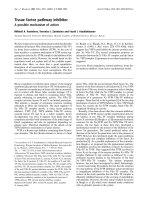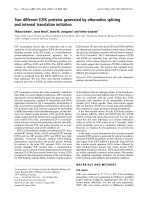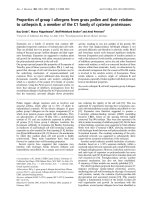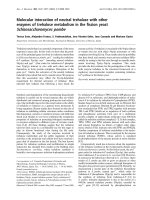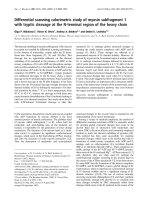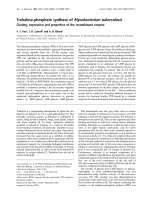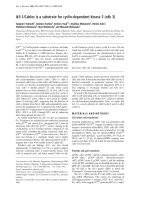Báo cáo y học: "Figuring out what works: a need for more and better studies on the relationship between ICU organization and outcomes" potx
Bạn đang xem bản rút gọn của tài liệu. Xem và tải ngay bản đầy đủ của tài liệu tại đây (117.7 KB, 2 trang )
In the previous issue of Critical Care, Billington and
colleagues [1] presented an intriguing study assessing
diff erences in intensive care unit (ICU) outcomes and
resource use according to the base specialty of
intensivists. While certain to be controversial, this type of
research is important, and we need much more of it. But,
fi rst, details about the study itself.
is retrospective statistical analysis used data from
three medical-surgical ICUs in Calgary, Alberta. All are
closed ICUs, with house staff , and a single intensivist in
charge for each block of time. Multivariable regression
was used to evaluate the association of outcomes and
resource use with the specialty training of their 26
intensivists. Specialties were divided into three groups:
(a) internal medicine, (b) internal medicine and
pulmonary subspecialty, or (c) all others, representing
anesthesia, surgery, and emergency medicine.
While not perfect, their analysis is appropriate,
adjusting for the type and severity of illness and a number
of other potentially confounding variables and using
methods to deal with the intrinsically clustered data.
ey found some diff erences according to intensivist
specialty, most prominent of which was that adjusted
ICU mortality was signifi cantly lower for patients under
the care of those trained in internal medicine and
pulmonary medicine. However, when all of their data
were considered, the association between the intensivists’
base specialty and outcomes was not very robust. As the
authors indicate, these fi ndings cannot be assumed to
represent a causal pathway, and without additional
studies they cannot be taken as either defi nitive or
generalizable. However, it is completely plausible that
such diff erences exist.
Variations in care and outcomes not related to patient
or illness characteristics have been found throughout the
health care system. Diff erences have been found at the
level of geographic region [2], hospital [3], physician
specialty, and individual physicians [4-6]. Widespread
variation occurs in ICUs as well [5-9]. It is commonly
recognized that diff erent kinds of specialists do things
diff erently. ere is even evidence for personality trait
diff erences among people in diff erent specialties, and
these diff erences in personality could infl uence practice
styles [10,11]. And there is no obvious reason to believe
that diff erences in practice could not translate to
diff erences in outcomes and resource use.
Despite its narrow focus and admitted limitations, the
paper by Billington and colleagues is important. It is
important because it represents a serious eff ort to peer
inside the black box of ICU organization and to under-
stand a detail of how ICU organization infl uences
outcomes.
With few of the diagnostic or therapeutic innovations
in ICU care over recent decades having produced
substantial improvements in outcomes, we must
recognize that equal or greater opportunities to improve
Abstract
Modifying how intensive care units (ICUs) are organized
and run o ers major opportunities to improve
outcomes. In the previous issue of Critical Care,
Billington and colleagues assessed the association of
outcomes with intensivists’ base speciality. However,
very little is known about the relationships between
ICU organization and outcomes. In the systems-based
paradigm of quality improvement, every aspect of what
we do and how we do it is a candidate for study and
change. While we need much more rigorous research
assessing every aspect of this large question, there are
substantial barriers to conducting such studies.
© 2010 BioMed Central Ltd
Figuring out what works: a need for more and
better studies on the relationship between ICU
organization and outcomes
Allan Garland*
See related research by Billington, et al., />COMMENTARY
*Correspondence:
University of Manitoba Health Sciences Centre, 820 Sherbrook Street - GF222,
Winnipeg, MB, Canada R3A 1R9
Garland Critical Care 2010, 14:108
/>© 2010 BioMed Central Ltd
ICU care derive from improving the structures and
processes that it consists of [12]. Outside of medicine, it
is widely accepted that most of the opportunities to
improve the performance of complex organizations
derive from improving the structures and processes that
they consist of. Although this vital concept is often
ignored by physicians, it is not absent from the medical
literature [13-15]. Within this systems-based concept,
every aspect of what we do and how we do it is a
candidate for study and change [12]; this list includes the
training and organization of intensivists. With a virtual
absence of information relating ICU training with ICU
outcomes, many questions remain unanswered. Is there
an optimal duration of training? What is the optimum
training curriculum? Are outcomes of certain types of
patients better under the care of intensivists with a
certain base specialty or ICU training or both? e goal
of asking these questions is not to exclude any sort of
physician from the community of intensivists, but rather
to work toward identifying the optimal way to train inten-
sivists to ensure that all ICU care is as good as it can be.
But the matter of intensivists and their training is just
one piece of this pie. Since little is known about the
relationships between ICU organization and outcomes,
we need much more and higher quality research assessing
every aspect of ICU organization to uncover how we
should organize ICU care to improve outcomes. And as
with any other kind of research, we will need numerous
studies from multiple sites to begin developing a
consistent and integrated understanding of this complex
topic. But there are steep barriers to conducting such
studies. ey are diffi cult to perform, get funded, and get
published. e impediments to doing randomized
controlled studies of organizational change in ICUs are
commonly insurmountable. is and other practical
considerations make it unfair to dismiss a study on this
topic because it is a retrospective statistical analysis of
what amounts to a natural experiment, or because it
derives from one or a few centers, or because it failed to
adjust for every potentially confounding variable that we
can imagine, or because it feels threatening to one’s
professional sense of self. Lastly, to promote organi-
zational research in health care, funding agencies need to
recognize its importance and institute plans to support it.
Abbreviation
ICU = intensive care unit.
Competing interests
The author declares that he has no competing interests.
Published: 27 January 2010
References
1. Billington EO, Zygun DA, Stelfox HT, Peets AD: Intensivists’ base specialty of
training is associated with variations in mortality and practice patterns.
Crit Care 2010, 13:R209.
2. Center for the Evaluative Clinical Sciences Sta : The Dartmouth Atlas of Health
Care 1999. Chicago, IL: American Hospital Publishing; 1999.
3. Burns LR, Wholey DR: The e ects of patient, hospital, and physician
characteristics on length of stay and mortality. Med Care 1991, 29:251-271.
4. Green eld S, Nelson EC, Zubko M, Manning W, Rogers W, Kravitz RL, Keller A,
Tarlov AR, Ware JE: Variations in resource utilization among medical
specialties and systems of care: results from the Medical Outcomes Study.
JAMA 1992, 267:1624-1630.
5. Garland A, Connors AF: Physicians’ in uence over decisions to forego life
support. J Palliat Med 2007, 10:1298-1305.
6. Garland A, Shaman Z, Baron J, Connors AF Jr.: Physician-attributable
di erences in intensive care unit costs: a single-center study. Am J Respir
Crit Care Med 2006, 174:1206-1210.
7. Ferrand E, Robert R, Ingrand P, Lemaire F, French LATEREA Group:
Withholding and withdrawal of life support in intensive-care units in
France: a prospective survey. Lancet 2001, 357:9-14.
8. Rapoport J, Gehlbach S, Lemeshow S, Teres D: Resource utilization among
intensive care patients: managed care vs. traditional insurance. Arch Intern
Med 1992, 152:2207-2222.
9. Rothen H, Stricker K, Einfalt J, Bauer P, Metnitz P, Moreno R, Takala J: Variability
in outcome and resource use in intensive care units. Intensive Care Med
2007, 33:1329-1336.
10. Gerrity MS, Earp JAL, DeVellis RF, Light DW: Uncertainty and professional
work: perceptions of physicians in clinical practice. Am J Sociol 1992,
97:1022-1051.
11. Merrill JM, Camacho Z, Laux LF, Lorimor R, Thornby JL, Vallbona C:
Uncertainties and ambiguities: measuring how medical students cope.
Med Educ 1994, 28:316-322.
12. Garland A: Improving the intensive care unit. Part 2. Chest 2005,
127:2165-2179.
13. Shortell SM, Singer SJ: Improving patient safety by taking systems
seriously.
JAMA 2008, 299:445-447.
14. Amalberti R, Auroy Y, Berwick D, Barach P: Five system barriers to achieving
ultrasafe health care. Ann Intern Med 2005, 142:756-764.
15. Berwick DM: Continuous improvement as an ideal in health care. N Engl J
Med 1989, 320:53-56.
Garland Critical Care 2010, 14:108
/>doi:10.1186/cc8843
Cite this article as: Garland A: Figuring out what works: a need for more
and better studies on the relationship between ICU organization and
outcomes. Critical Care 2010, 14:108.
Page 2 of 2

